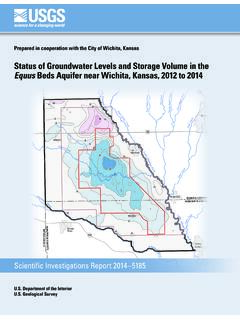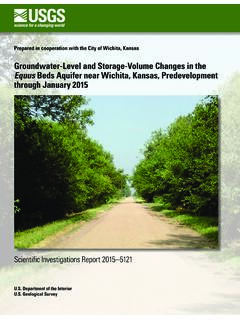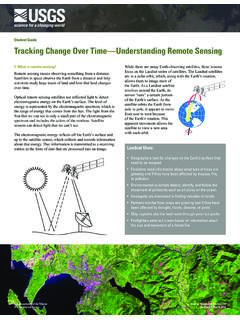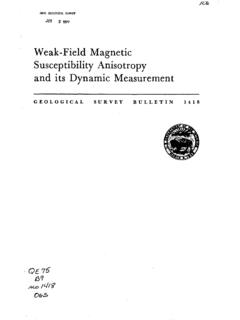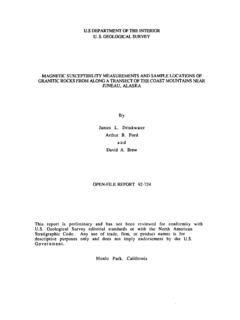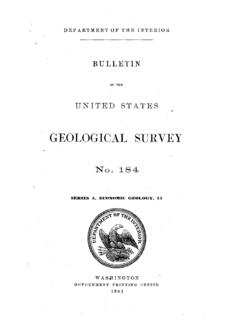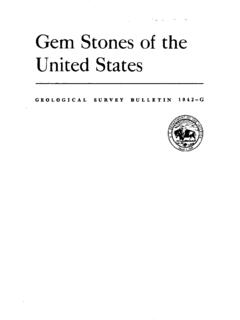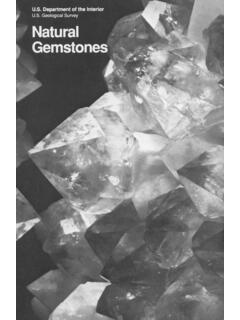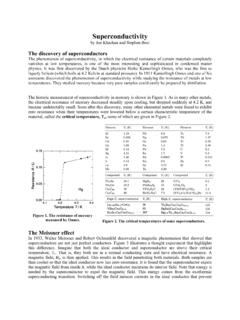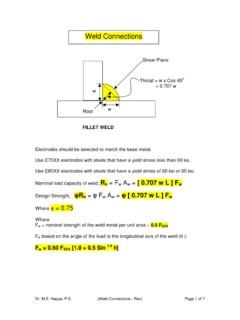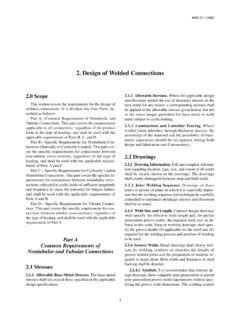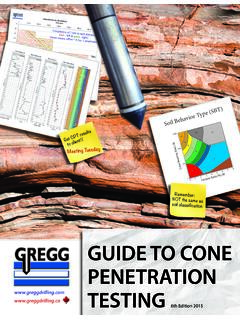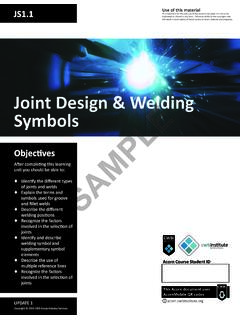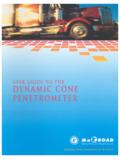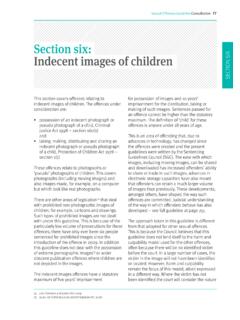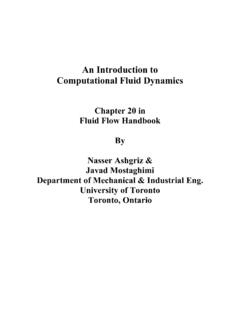Transcription of Methods of Measuring - USGS
1 Methods of Measuring soil moisture in the FieldBy A. I. JOHNSONCONTRIBUTIONS TO THE HYDROLOGY OF THE UNITED STATES GEOLOGICAL SURVEY WATER-SUPPLY PAPER 1619-UEvaluates Methods for Measuring soil moisture and describes the equipment usedUNITED STATES GOVERNMENT PRINTING OFFICE, WASHINGTON : DEPARTMENT OF THE INTERIOR MANUEL LUJAN, Jr., GEOLOGICAL SURVEY Dallas L. Peck, DirectorFirst printing 1962 Second printing 1963 Third printing 1992 Any use of trade, product, or firm names in this publication is for descriptive purposes only and does not imply endorsement by the Gover nmentFor sale by the Books and Open-File Reports Section Geological Survey, Federal Center, Box 25425, Denver, CO 80225 CONTENTS Page Abstract__ _ _____ 2 Gravimetric __ _____ 2 Sample 2 Sampling augers_____ 3 Sampling tubes or core barrels_____ 4 Porter piston 4 Pomona open-drive 5 Johnson open-drive 5 Electrical-resistance.
2 _____ 6 Heat-diffusion, 9 Absorption _____ _____ 12 Radioactive. 12 Summary _____ 14 Selected _____ _____ 15A. Gravimetric 15B. Electrical-resistance . 16C. Heat-diffusion Methods -_---_---_-----__---------------- ---- 19D. Absorption methods_____ 19E. Tensiometric 20F. Penetration 21G. Radioactive methods__-_-------_--------_--------_--_ ------ 21H. General methods__--_-_---_-----------_---------- -_---_--- 24 ILLUSTRATIONSPageFIGURE 1. Orchard U-32. Porter piston 43. Pomona open-drive 54. Johnson open-drive 65. Electrical-resistance soil - moisture blocks and 86. Tensiometers _ _____ 117. Radioactive soil - moisture 13inCONTRIBUTIONS TO THE HYDROLOGY OF THE UNITED STATESMETHODS OF Measuring soil moisture IN THEFIELDBy A.
3 I. JOHNSONABSTRACTFor centuries, the amount of moisture in the soil has been of interest in agriculture. The subject of soil moisture is also of great importance to the hydrologist, forester, and soils equipment and many Methods have been developed to measure soil moisture under field conditions. This report discusses and evaluates the various Methods for measurement of soil moisture and describes the equipment needed for each method. The advantages and disadvantages of each method are discussed and an extensive list of references is provided for those desiring to study the subject in more gravimetric method is concluded to be the most satisfactory method for most problems requiring onetime moisture -content data.
4 The radioactive method is normally best for obtaining repeated measurements of soil moisture in place. It is concluded that all Methods have some limitations and t^at the ideal method for measurement of soil moisture under field conditions has yet to be subject of soil moisture has long; been of interest in agriculture. For centuries the farmer has picked up and felt a handful of soil to determine the best time to plow his fields. The amount of moisture in the soil is also of great importance in hydrology, forestry, and soil - mechanics engineering. Consequently, much effort has been expended in the last 50 years in developing Methods and equipment for meas- uring soil moisture under field of soil moisture is one of the most difficult measure- ments required in the field of hydrology.
5 Measurement of soil mois- ture ranges from the method of feeling the soil to the use of complicated electronic equipment using radioactive substances. The development of equipment has been directed primarily toward instruments that continuously measure changes in moisture content at a single sampling CONTRIBUTIONS TO THE HYDROLOGY OF THE UNITED STATESMETHODSGRAVIMETRICThe gravimetric method involves collecting a soil samp1 ^ weighing the sample before and after drying it, and calculating its original moisture content. The gravimetric method is the oldest (other than the ancient method of feeling the soil ) but still continues to be the most widely used method for obtaining data on soil moisture .
6 Because it is the only direct way of Measuring soil moisture , it is required for calibrating the equipment used in the oth sr (II, 1950) 1 reporting on work completed in 1843 and Whitney (A, 1894), describe some of the first scientific investigations of soil moisture using gravimetric Methods . The Kirg tube, for collecting drive-core samples, was developed in 1890 and vus modified and improved by Veihmeyer (A, 1929). Since that time many types of sampling equipment, as well as special drying ovens and balances, have been developed for use with the gravimetric methoc1 .The disadvantage of the gravimetric method is the tirr e and effort required to obtain data.
7 It is time-consuming work tc collect the samples, especially from depths greater than a few feet, and to oven dry and weigh the many samples required for most projects. For many problems, such as the study of evapotranspiration by grasses, the sampling procedure alters the area of experiment owing to trampling of the vegetation or the making of numerous hcles. Under these conditions, the sampling may have to be done from platforms, and the holes may have to be refilled and packed. Soils normally variable within an experimental area and, as two samples cannot be collected from the same point, slight variations of moisture content may be COLLECTIONFor the best samples, the soil should be homogeneous-, just moist enough to permit easy cutting by the sampling equipment, and free from roots, organic matter, and stones.
8 Seldom are all these con- ditions technique and equipment used for sample collection should be such that the samples do not lose or gain moisture , or otherwise become altered or contaminated, during sampling and transportation. In sampling through a wet layer into a dry layer, care must, be taken to keep the sampling equipment as dry as possible and to prevent water1 Letters refer to the center beads In "Selected References," as follows: A, Gravimetric method ; B, Electrical-resistance method ; C, Heat-diffusion method ; D, Absorption method ; B, Tenslometric method; P, Penetration method; G, Radioactive method; H, General OF Measuring soil moisture IN THE FIELD U-3from running down the hole into the drier material.
9 If there is free water in the soil , the moisture content as measured probably will be less than the correct value because some water will drip off as the sam- ple is removed from the ground, or some may be squeezed out by compaction during dry hard fine-textured sediments are encountered, it is dif- ficult to drive the core barrels or to rotate the augers. When dry, coarse-textured sediments are sampled, the sample may slide out the end of the core barrel or auger as it is withdrawn. Stony soils are very difficult to sample, especially volumetrically, owing to the danger of hitting a stone with the cutting edges of the equipment and because representative samples must be large.
10 Soils that contain a considerable amount of roots and organic matter also present soil - moisture sampling, it is essential that all sampling opera- tions the transfer of samples to moisture cans and the weighing of the moist samples be done as rapidly as possible to prevent undue moisture losses. Many difficulties in the use of sampling equipment, whether augers or core samplers, may be overcome if all equipment is kept clean that is, free of moisture , oil, rust, and AUGERSThe simplest equipment for soil - moisture sampling is the hand auger. Hand augers, with shaft extensions of aluminum pipe, have been used in sampling to depths as great as 55 of the most useful types of hand augers is the Orchard auger (fig.)
